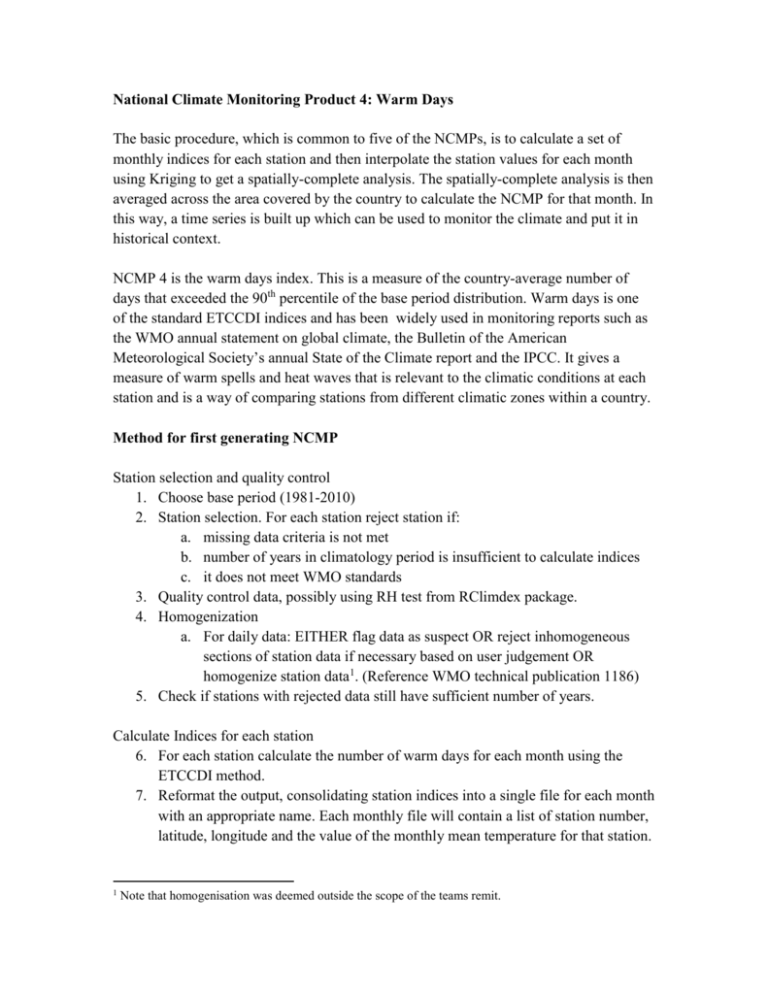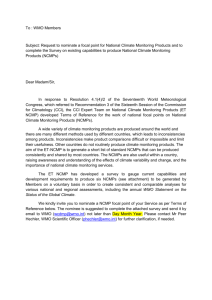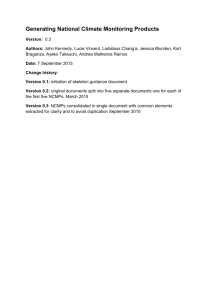Four part framework
advertisement

National Climate Monitoring Product 4: Warm Days The basic procedure, which is common to five of the NCMPs, is to calculate a set of monthly indices for each station and then interpolate the station values for each month using Kriging to get a spatially-complete analysis. The spatially-complete analysis is then averaged across the area covered by the country to calculate the NCMP for that month. In this way, a time series is built up which can be used to monitor the climate and put it in historical context. NCMP 4 is the warm days index. This is a measure of the country-average number of days that exceeded the 90th percentile of the base period distribution. Warm days is one of the standard ETCCDI indices and has been widely used in monitoring reports such as the WMO annual statement on global climate, the Bulletin of the American Meteorological Society’s annual State of the Climate report and the IPCC. It gives a measure of warm spells and heat waves that is relevant to the climatic conditions at each station and is a way of comparing stations from different climatic zones within a country. Method for first generating NCMP Station selection and quality control 1. Choose base period (1981-2010) 2. Station selection. For each station reject station if: a. missing data criteria is not met b. number of years in climatology period is insufficient to calculate indices c. it does not meet WMO standards 3. Quality control data, possibly using RH test from RClimdex package. 4. Homogenization a. For daily data: EITHER flag data as suspect OR reject inhomogeneous sections of station data if necessary based on user judgement OR homogenize station data1. (Reference WMO technical publication 1186) 5. Check if stations with rejected data still have sufficient number of years. Calculate Indices for each station 6. For each station calculate the number of warm days for each month using the ETCCDI method. 7. Reformat the output, consolidating station indices into a single file for each month with an appropriate name. Each monthly file will contain a list of station number, latitude, longitude and the value of the monthly mean temperature for that station. 1 Note that homogenisation was deemed outside the scope of the teams remit. Calculate variogram for this index for the country 8. Read in index for all Januarys from all stations in the base period 9. For each January and each pair of stations, calculate the difference in the index reported at each station and the distance between the stations. 10. Plot the variogram, which is a scatter plot of difference as a function of distance for all pairs 11. Find functional form and parameters of the variogram, f(|a-b|, θ1, θ2, θ3…), which relates the distance between the stations, |a-b|, to the variance, that best fits the data for all Januarys in the base period chosen from the functional forms Exponential, Gaussian or Spherical. This can be done by eye, or by minimizing the root mean squared error. 12. Repeat a-d for January, February, March and save the results Calculate infilled data set for each available month 13. Define a regular latitude-longitude grid across the country ensuring that there are sufficient grid cells to resolve the major outline of the country. 14. Read in data for one month (e.g. March 1999) 15. Read in the variogram parameters from step 12. 16. Use Ordinary Kriging together with the station data and the variogram to estimate the values at each of the grid-cell centres 17. Output the interpolated data. Calculate area average for each available month 18. Read in interpolated data for one month (e.g. March 1999) 19. Overlay country boundaries and mask out grid cells outside the boundaries. 20. Calculate the area of each grid cell a. Where a grid cell falls wholly within the country’s borders the area is set equal to the area of the grid cell. b. Where a grid cell is divided by the borders of the country, calculate the area of the grid cell that falls within the country’s boundary. 21. Calculate average from all grid cells weighted by the area of the grid cell within the country including both complete and incomplete grid cells. This is the NCMP for the month Output of NCMP 22. Write out NCMP for this month in standard format (Year, Month, Country, NCMP indicator, NCMP value, Number of stations contributing, quality flag, length of record, normal period). 23. Combine individual NCMPs into standard format and transmit combined NCMP in agreed format via agreed protocol. Regular monthly updates 1. Append latest daily data to station records 2. Update the monthly indices 3. Calculate the NCMP for the month using Steps 13-23 above. Regular annual updates 4. Every year reassess Steps 1 to 5 and, if necessary recalculate the indices and variograms.







